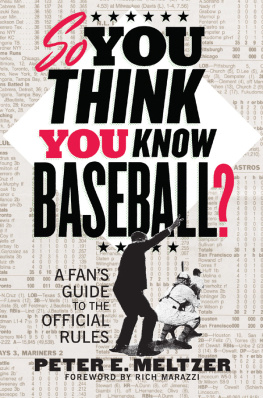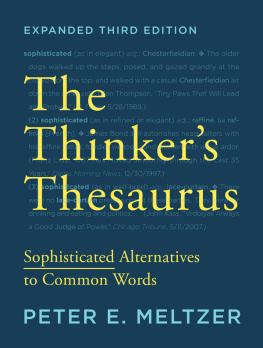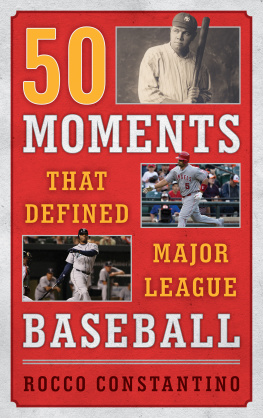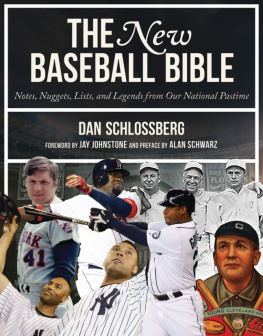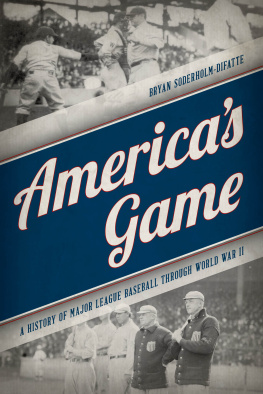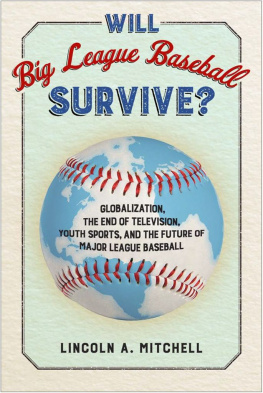

A FANS GUIDE TO THE OFFICIAL RULES
Peter E. Meltzer

To Aaron, Joel, Mark, Mike, and Steve
Five mensches with five wonderful wives
CONTENTS
PART ONE
RULES ON THE FIELD
PART TWO
SPECIALIZED ON-THE-FIELD SITUATIONS
PART THREE
THE OFFICIAL SCORER
When Peter Meltzer approached me about this book project, I was apprehensive about getting involved. I knew he was taking on a massive undertaking since the Official Baseball Rules has historically created challenges for the best baseball minds in the game.
I was aware that Peters game plan to identify, explain, and assess most rules was a daunting task. But after careful review, I believe that he has met the challenge through a uniquely written format that triggers the thinking of the reader through a plethora of questions and an opinionated analysis of baseballs playing and scoring rules.
The reader is quizzed about the rules through a series of pertinent questions drawn from actual plays that have occurred in a major league game as opposed to mere hypotheticals. To my knowledge, this is the first baseball book ever written that contains this feature. In my opinion this is the books greatest asset as the author engages the reader throughout. His carefully designed questions based on actual plays are a valuable learning technique that is absent from most previously written rules-related books.
In my thirty-five years or so as a rules columnist, and now rules consultant for several major league teams, I have never encountered such a book that not only teaches the reader about the rules of the game, but explores the intricacies and nuances of the more common rules as well as the obscure.
While any analysis of the Official Baseball Rules is subject to individual interpretation, it is my opinion after reviewing Peters efforts that all rules-related questions are appropriate and answered with accuracy.
The smooth flow of the book enables the reader to maintain a high level of interest about a subject that is loaded with complexities and nuances often subject to interpretation. I have often said that a rule is often like an onion because there are so many layers. Meltzer uncovers the layers through his practical examples and evaluation of the rule.
If you enjoy being challenged and want to have some fun, sit back, relax, and enjoy an exciting journey through the hills and valleys of the Official Baseball Rules.
ABOUT RICH MARAZZI
Rich Marazzi has served as the rules consultant for various Major League Baseball organizations, including the New York Yankees, Boston Red Sox, Toronto Blue Jays, Cleveland Indians, Arizona Diamondbacks, and Houston Astros, and is considered the first rules consultant in Major League Baseball history. He has authored five baseball books, including The Rules and Lore of Baseball. He has been a monthly rules columnist for Baseball Digest since 1988 and has also served in the same capacity for Yankees Magazine and Referee magazine over the years. Rich is also currently a rules columnist for USA Today Sports Weekly , New England Baseball Journal , the ABUA Web site (www.umpire.org), and Collegiate Baseball . He also hosts a weekly baseball radio talk show on 97.9 ESPN and ESPN Radio 1300 in Connecticut.
Every sport has its rabid fans, but none enjoy discussing the rules of their sport so much as baseball fans. Virtually anytime a play occurs in a major league game that involves interpretation of a baseball rule, one can be sure that the next days newspapers (and even more so the blogosphere) will have a full analysis of the play, the rule it brought into question, and especially whether or not the umpire (or the official scorer) got the call right. We are a nation of armchair umpires.
Why the fascination with baseball rules? Numbers and statistics are part of it. Baseball has a rich history of capturing every aspect of the performance of every player ever since the game began.
The Major League Baseball rulebook (the Official Baseball Rules ) has two components. The first (sections 2 through 9) relates to the action on the field that can affect the outcome of the game and how umpires should deal with game situations. Did the ball hit the runner? Does the infield fly rule apply to that pop-up? Didnt the fielder obstruct the runner? Does that run count even though the third out occurred on the play? Can the batter run to first after the catcher did not catch strike three?
The second component (section 10) relates specifically to how the action on the field should be scoredi.e., the statistical component. Should that mental mistake by the fielder have been counted as an error? Does the runner get credit for a stolen base on a wild throw? Does the hitter get credit for an RBI even though he hit into a double play? Does the pitcher get credit for a save even though his team was up by 5 runs?
Though part of the same rulebook, the two sections are entirely distinct from one another: one is the province of the umpires on the field, the other is the province of the official scorer. Indeed, they are so distinct that a Major League Baseball umpire is neither required nor presumed to have any specialized expertise regarding the official scorer rules, and the official scorer is neither required nor presumed to have any specialized expertise regarding the umpiring rules.
The official scorer section demonstrates another way in which the sport of baseball is unique. Statistics are a far more important part of baseball than of any other sport.
Consider the following: On June 2, 2010, the Tigers Armando Galarraga retired the first twenty-six Cleveland Indians batters he faced. Had he retired the next batter, Jason Donald, he would have thrown a perfect game. Donald hit a grounder to the first baseman, Miguel Cabrera, who threw to Galarraga, who was covering first. Although Donald was clearly out on the play, umpire Jim Joyce mistakenly called him safe, thus ruining Galarragas perfect game (Joyce admitted as much the moment he saw the replay after the game). Galarraga retired the next batter, and the Tigers won 30.
A Google search of this play just a few days after it occurred turned up over half a million hits from around the world, discussing it from every angle. Of course, blown umpire or referee calls are nothing new in sports, with plenty of famous (or infamous) instances of such blown calls in every sport. But, only in baseball could there be such a firestorm over a blown call that had no effect on the outcome of the game at all . The Tigers won the game immediately afterward anyway. Every time there has been a controversy about a blown call in other sports it is because that call had an impact on the result of the game. In this case, the blown call made no difference whatsoever in that respect. It was important only statisticallyperfect games are rare in baseball, and because fans of the game pay attention to statistics and history, Joyces blown call mattered.
This book is unique in three respects. First, it is the only book that focuses on actual Major League Baseball plays as opposed to dry hypotheticals invented by the author. This brings the plays to life and lets the reader know that umpires (or official scorers) actually had to deal with the situations at hand. It is more entertaining to analyze plays that have actually occurred as opposed to those created by the writer. (It is also much more time-consumingit has taken over three years to locate all the plays and situations in this book.) Second, it is the only book that analyzes every baseball rule that has been the subject of interpretation. It does not merely consider a random rule here and there, in hodgepodge fashion. Third, it is the only book that analyzes both the action on the field rules and the official scorer rules.
Next page
